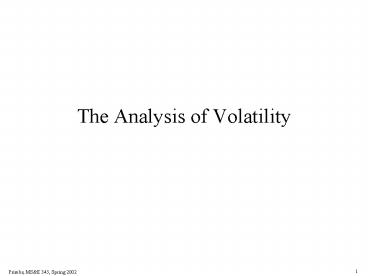The Analysis of Volatility - PowerPoint PPT Presentation
1 / 30
Title:
The Analysis of Volatility
Description:
Mean Variance Skewness Kurtosis. Red (Gaussian) 0 1 0 3. Blue 0 1 -0.5 3 ... Mean Variance Skewness Kurtosis. 0.0007 0.0089 -0.3923 3.8207 ... – PowerPoint PPT presentation
Number of Views:59
Avg rating:3.0/5.0
Title: The Analysis of Volatility
1
The Analysis of Volatility
2
Historical Volatility
Volatility Estimation (MLE, EWMA, GARCH...)
Maximum Likelihood Estimation
Implied Volatility
Smiles, smirks, and explanations
3
In the Black-Scholes formula, volatility is the
only variable that is not directly observable in
the market.
Therefore, we must estimate volatility in some
way.
4
(I am following Hull, 2000 now)
A Standard Volatility Estimate
5
Note
If m is large, it doesnt matter which one you
use...
6
Note
Why is this okay?
It is very small over small time periods, and
this assumption has very little effect on the
estimates.
7
Weighting Schemes
Furthermore, I will allow for the volatility to
change over time. So sn2 will denotes the
volatility at day n.
8
Weighting Schemes
An Extension
This is known as an ARCH(m) model
ARCH stands for Auto-Regressive Conditional
Heteroscedasticity.
9
Homoscedastic and Heteroscedastic
If the variance of the error e is constant, it is
called homoscedastic.
However, if the error varies with x, it is said
to be heteroscedastic.
10
Weighting Schemes
11
Weighting Schemes
You can also have GARCH(p,q) models which depend
on the p most recent observations of u2 and the q
most recent estimates of s2.
12
Historical Volatility
Volatility Estimation (MLE, EWMA, GARCH...)
Maximum Likelihood Estimation
Implied Volatility
Smiles, smirks, and explanations
13
How do you estimate the parameters in these
models?
One common technique is Maximum Likelihood
Methods
Idea Given data, you choose the parameters in
the model the maximize the probability that you
would have observed that data.
14
Maximum Likelihood Methods
Example
Estimate the variance of a normal distribution
from samples
Given u1,...,um.
15
Maximum Likelihood Methods
Example
It is usually easier to maximize the log of
f(uv).
16
Maximum Likelihood Methods
We can use a similar approach for a GARCH model
The problem is to maximize this over w, a, and b.
17
Historical Volatility
Volatility Estimation (MLE, EWMA, GARCH...)
Maximum Likelihood Estimation
Implied Volatility
Smiles, smirks, and explanations
18
Implied Volatility
Let cm be the market price of a European call
option.
This can be thought of as the estimate of
volatility that the market is using to price
the option.
19
The Implied Volatility Smile and Smirk
Market prices of options tend to exhibit an
implied volatility smile or an implied
volatility smirk.
20
Where does the volatility smile/smirk come from?
Heavy Tail return distributions
Crash phobia (Rubenstein says it emerged after
the 87 crash.)
Leverage (as the price falls, leverage increases)
Probably many other explanations...
21
Why might return distributions have heavy tails?
Heavy Tails
Stochastic Volatility
Jump diffusion models
Risk management strategies and feedback effects
22
How do heavy tails cause a smile?
This option is worth more
This option is not necessarily worth more
23
Important Parameters of a distribution
GaussianN(0,1)
0
1
0
3
24
Mean
Variance Skewness Kurtosis Red (Gaussian)
0 1 0
3 Blue
0 1 -0.5
3
Skewness tilts the distribution on one side.
25
Mean
Variance Skewness Kurtosis Red (Gaussian)
0 1 0
3 Blue
0 1 0
5
Large kurtosis creates heavy tails (leptokurtic)
26
Empirical Return Distribution
Mean Variance Skewness
Kurtosis 0.0007
0.0089 -0.3923
3.8207
(Data from the Chicago Mercantile Exchange)
(Courtesy of Y. Yamada)
27
Volatility Smiles and Smirks
10 days to maturity
Mean Square Optimal Hedge Pricing
(Courtesy of Y. Yamada)
28
Volatility Smiles and Smirks
20 days to maturity
Mean Square Optimal Hedge Pricing
(Courtesy of Y. Yamada)
29
Volatility Smiles and Smirks
40 days to maturity
Mean Square Optimal Hedge Pricing
(Courtesy of Y. Yamada)
30
Volatility Smiles and Smirks
80 days to maturity
Mean Square Optimal Hedge Pricing
(Courtesy of Y. Yamada)































